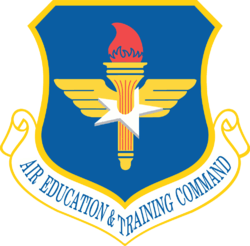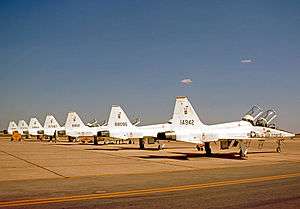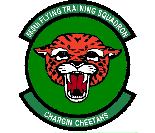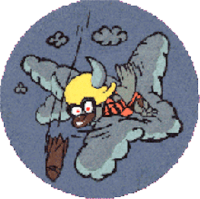560th Flying Training Squadron
560th Flying Training Squadron
 | |
|---|---|
 | |
| Active | 1942–1945; 1947–1949; 1962–1970; 1972–present |
| Country |
|
| Branch |
|
| Role | Pilot Training |
| Part of | Air Education and Training Command |
| Garrison/HQ | Randolph Air Force Base |
| Nickname(s) | Chargin' Cheetahs |
| Engagements | European Theater of Operations[1] |
| Decorations |
Distinguished Unit Citation Air Force Outstanding Unit Award[1] |
| Insignia | |
| 560th Flying Training Squadron emblem (modified 13 April 1995)[1] |
 |
| 560th Bombardment Squadron emblem[2] |
 |
The 560th Flying Training Squadron is part of the 12th Flying Training Wing of the United States Air Force based at Randolph Air Force Base, Texas. It operates the Northrop T-38 Talon conducting flying training.
History
World War II
The 560th was first activated as the 560th Bombardment Squadron at Gowen Field, Idaho, one of the four original squadrons of the 388th Bombardment Group, in December 1942.[1][3] The squadron trained with Boeing B-17 Flying Fortress heavy bombers until June 1943, when it deployed to England. The squadron flew its first combat mission on 17 July, when it attacked an aircraft factory in Amsterdam. The squadron primarily engaged in the strategic bombing campaign against Germany, attacking industrial sites, oil refineries and storage facilities, communications centers and naval targets on the European Continent.[3]
The squadron was awarded a Distinguished Unit Citation (DUC) for attacking an aircraft factory at Regensburg, Germany, on 17 August 1943, withstanding heavy resiistance to reach the target. It was awarded a second DUC for three separate missions: an earlier attack on a tire and rubber factory in Hanover, Germany on 26 July 1943 and two missions in 1944, one against synthetic oil refineries near Brüx, Germany[note 2] on 12 May and at Ruhland, Germany on 21 June. This last attack was on a shuttle bombing mission from England to Germany to Poltava, USSR,[note 3] to Foggia, Italy, and back to England.[3][4]
Reserve operations
The squadron was activated in the reserves at Orchard Place Airport, Illinois on 6 March 1947. It was assigned to the 338th Bombardment Group, which had been activated at Orchard Place in July 1947, at the end of September.[1][5] The squadron trained under the supervision of Air Defense Command (ADC)'s 141st AAF Base Unit (Reserve Training) (later the 2471st Air Force Reserve Flying Training Center), although it does not appear that it was fully manned or equipped.[6]
In July 1948 Continental Air Command (ConAC) assumed responsibility for managing reserve and Air National Guard units from ADC.[7] The 560th was inactivated when ConAC reorganized its reserve units under the wing base organization system in June 1949. President Truman’s reduced 1949 defense budget also required reductions in the number of units in the Air Force,[8] At O'Hare, the 338th Group and its squadrons were inactivated, and most of its personnel transferred to the 437th Troop Carrier Wing.[5][9]
Fighter operations
Beginning in October 1962, the squadron, having been redesignated as a tactical fighter unit, conducted tactical operations and training in preparation for global deployment. It deployed to South Korea in response to North Korea's capture of the USS Pueblo in June 1969. After maintaining alert status in Korea and later Japan, the squadron was redeployed to Homestead Air Force Base, Florida where it was inactivated in October 1970.[4]
Pilot training
On 1 May 1972, the 560th was reactivated at Randolph Air Force Base, Texas, and took over the mission of training Northrop T-38 Talon instructor pilots for Air Training Command's Undergraduate Pilot Training bases.[4]
In October 1993, the 560th took on the mission of Introduction to Fighter Fundamentals and Upgrade Instructor Pilot Training in the "Smurf Jet" AT-38. In May 1998, the Smurf operation had become squadron-sized and was split off to reactivate the 435th Fighter Training Squadron. The 560th still prepares rated pilots from varied backgrounds for fighter lead-in training.[4]
Additionally, the 560th maintains ties with Vietnam era prisoner of war (POW) pilots. Since 1973, all repatriated pilots, physically able to return to active flying duty came to the 560th for requalification training. As the final chapter in Operation Homecoming, the squadron returned more than 150 active duty pilots to flight status. Over the next two years the 560th flew more than 6000 hours and established a lasting bond with these former POWs.[4]
Lineage
- Constituted as the 560th Bombardment Squadron (Heavy) on 19 December 1942
- Activated on 24 December 1942
- Redesignated 560th Bombardment Squadron, Heavy on 20 August 1943
- Inactivated on 28 Aug 1945
- Redesignated 560th Bombardment Squadron, Very Heavy on 6 February 1947
- Activated in the reserve on 6 March 1947
- Inactivated on 27 June 1949
- Redesignated 560th Tactical Fighter Squadron and activated, on 1 May 1962 (not organize)
- Organized on 1 October 1962
- Inactivated on 31 October 1970
- Redesignated 560th Flying Training Squadron on 22 March 1972
- Activated on 1 May 1972[1]
Assignments
|
|
Stations
|
|
Aircraft Operated
- Boeing B-17 Flying Fortress (1943–1945)
- North American F-100 Super Sabre (1962–1964)
- Republic F-105 Thunderchief (1963–1968)
- McDonnell F-4 Phantom II (1969–1970)
- Northrop T-38 Talon (1972–present)[1]
References
Notes
- Explanatory notes
- Citations
- 1 2 3 4 5 6 7 8 Robertson, Patsy (September 6, 2012). "Factsheet 560 Flying Training Squadron (AETC)". Air Force Historical Research Agency. Retrieved September 20, 2018.
- ↑ Watkins, pp. 76-77
- 1 2 3 Maurer, Combat Units, pp. 275-276
- 1 2 3 4 5 "560th Flying Training Squadron History". 502d Air Base Wing Public Affairs. December 12, 2006. Archived from the original on July 20, 2011. Retrieved September 17, 2018.
- 1 2 Maurer, Combat Units, pp. 217–218
- ↑ See Robertson. (No known aircraft listed for squadron during this period).
- ↑ "Abstract, Mission Project Closeup, Continental Air Command". Air Force History Index. 27 December 1961. Retrieved March 24, 2014.
- ↑ Knaack, p. 25
- ↑ Ravenstein, pp. 233-234
- ↑ Station number in Anderson.
- ↑ Station information in Robertson, except as noted.
Bibliography
![]()
- Anderson, Capt. Barry (1985). Army Air Forces Stations: A Guide to the Stations Where U.S. Army Air Forces Personnel Served in the United Kingdom During World War II (PDF). Maxwell AFB, AL yes: Research Division, USAF Historical Research Center. Archived from the original (PDF) on January 23, 2016. Retrieved June 28, 2017.
- Knaack, Marcelle Size (1978). Encyclopedia of US Air Force Aircraft and Missile Systems (PDF). Vol. 2, Post-World War II Bombers 1945-1973. Washington, DC: Office of Air Force History. ISBN 0-912799-59-5. Retrieved December 17, 2016.
- Maurer, Maurer, ed. (1983) [1961]. Air Force Combat Units of World War II (PDF) (reprint ed.). Washington, DC: Office of Air Force History. ISBN 0-912799-02-1. LCCN 61060979.
- Maurer, Maurer, ed. (1982) [1969]. Combat Squadrons of the Air Force, World War II (PDF) (reprint ed.). Washington, DC: Office of Air Force History. ISBN 0-405-12194-6. LCCN 70605402. OCLC 72556.
- Ravenstein, Charles A. (1984). Air Force Combat Wings, Lineage & Honors Histories 1947-1977 (PDF). Washington, DC: Office of Air Force History. ISBN 0-912799-12-9. Retrieved December 17, 2016.
- Watkins, Robert (2008). Battle Colors: Insignia and Markings of the Eighth Air Force In World War II. Vol I (VIII) Bomber Command. Atglen, PA: Shiffer Publishing Ltd. ISBN 0-7643-1987-6.
